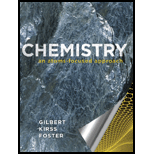
To find:
The partial pressure of
Answer to Problem 10.108QA
Solution:
The partial pressure of
Explanation of Solution
1) Concept:
We are asked to find the partial pressure of
According to Dalton’s law of partial pressure, the partial pressure of an individual is equal to the product of its mole fraction and total pressure.
i.e.,
where,
Mole fraction is the ratio of moles of individual component to the total moles in the mixture.
i.e.
2) Formula:
i)
ii)
3) Given:
i)
ii)
iii)
iv)
v)
4) Calculation:
i) The balanced equation for the reaction is
Finding the limiting reactant as follows:
As the two reactants are in stoichiometric amounts, both are completely consumed. So, after the reaction is complete, only gaseous products are present, which will govern the total pressure.
ii) From the stoichiometry of the reaction, one mole of
From the stoichiometry of the reaction, one mole of
Calculating the mole fraction of
Calculating the partial pressure of
Conclusion:
Dalton’s law of partial pressure is used to find partial pressure of each of the gaseous compound in a given reaction.
Want to see more full solutions like this?
Chapter 10 Solutions
Chemistry: An Atoms-Focused Approach
 ChemistryChemistryISBN:9781305957404Author:Steven S. Zumdahl, Susan A. Zumdahl, Donald J. DeCostePublisher:Cengage Learning
ChemistryChemistryISBN:9781305957404Author:Steven S. Zumdahl, Susan A. Zumdahl, Donald J. DeCostePublisher:Cengage Learning ChemistryChemistryISBN:9781259911156Author:Raymond Chang Dr., Jason Overby ProfessorPublisher:McGraw-Hill Education
ChemistryChemistryISBN:9781259911156Author:Raymond Chang Dr., Jason Overby ProfessorPublisher:McGraw-Hill Education Principles of Instrumental AnalysisChemistryISBN:9781305577213Author:Douglas A. Skoog, F. James Holler, Stanley R. CrouchPublisher:Cengage Learning
Principles of Instrumental AnalysisChemistryISBN:9781305577213Author:Douglas A. Skoog, F. James Holler, Stanley R. CrouchPublisher:Cengage Learning Organic ChemistryChemistryISBN:9780078021558Author:Janice Gorzynski Smith Dr.Publisher:McGraw-Hill Education
Organic ChemistryChemistryISBN:9780078021558Author:Janice Gorzynski Smith Dr.Publisher:McGraw-Hill Education Chemistry: Principles and ReactionsChemistryISBN:9781305079373Author:William L. Masterton, Cecile N. HurleyPublisher:Cengage Learning
Chemistry: Principles and ReactionsChemistryISBN:9781305079373Author:William L. Masterton, Cecile N. HurleyPublisher:Cengage Learning Elementary Principles of Chemical Processes, Bind...ChemistryISBN:9781118431221Author:Richard M. Felder, Ronald W. Rousseau, Lisa G. BullardPublisher:WILEY
Elementary Principles of Chemical Processes, Bind...ChemistryISBN:9781118431221Author:Richard M. Felder, Ronald W. Rousseau, Lisa G. BullardPublisher:WILEY





